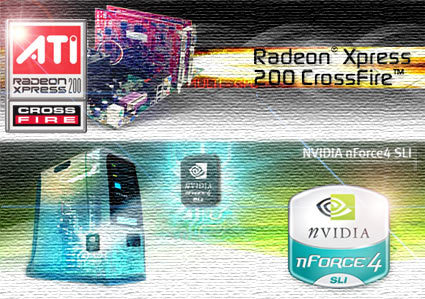The Dual Graphics Platform Battle, Part 1
ATI Multi Video Processing Vs. NVIDIA Scalable Link Interface

The war between the two major players in the graphics business, namely ATI and NVIDIA, has been going on for many years. Each side asserts that its technologies are superior on a regular basis, and try to gain ground on the other by any means necessary.
New graphics products hit the market several times a year, constantly adding features and performance to 3D graphics. Value has multiplied, but at the same time, it has become tough to keep track on all the product cycles. Dual graphics platforms look like the pinnacle in graphics technology today, but they also need to be clearly depicted as the very clever strategic moves they are.
Although both graphics vendors are thriving - ATI's Xenos powers the Microsoft Xbox360, and NVIDIA the Sony Playstation 3 - they needed to find ways of selling more graphics hardware into the PC market. Running two VGA cards for powering games and 3D applications seems to be a feasible idea - first, because 3Dfx already did this in 1998; and second, because this fits into the trend of increasing parallelism. In addition, a working chipset line is worth being pursued for the AMD platforms, because unlike Intel, the chip maker doesn't supply the vast majority of chipsets by itself.
NVIDIA was first to offer a platform for deployment of a graphics card couple. The technology is called Scalable Link Interface (SLI) and is available in a number of NVIDIA nForce4 chipsets for either AMD or Intel processors. ATI announced its Crossfire Multi Video Processing (MVP) counterattack earlier this year, but was not able to actually ship the product - until now.
Stay On the Cutting Edge: Get the Tom's Hardware Newsletter
Get Tom's Hardware's best news and in-depth reviews, straight to your inbox.
Current page: ATI Multi Video Processing Vs. NVIDIA Scalable Link Interface
Next Page ATI Vs. NVIDIA... Encore Une Fois